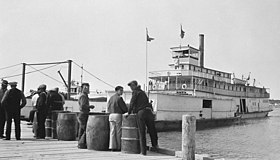Northern Alberta
Northern Alberta | |
|---|---|
|
Left-right from top: |
Northern Alberta is a geographic region located in the Canadian province of Alberta.
An informally defined cultural region, the boundaries of Northern Alberta are not fixed. Under some schemes, the region encompasses everything north of the centre of the Calgary–Edmonton Corridor, including most of the province's landmass as well as its capital, Edmonton. Other schemes place Edmonton and its surrounding farmland in Central Alberta, limiting Northern Alberta to the northern half of the province, where forestry, oil, and gas are the dominant industries.
Its primary industry is
Geography
Various definitions exist of Northern Alberta's boundaries. The definition used by the Northern Alberta Development Council, an agency of the provincial government, includes the communities of Whitecourt, Athabasca, Saddle Lake, St. Paul, and Cold Lake, while excluding Hinton, Edson, Mayerthorpe, and Westlock. This definition is also used by the University of Alberta to define eligibility for northern research grants.[2]
The region consists of
The southwest of the region is part of the
Northern Alberta is crossed by the
The
Other tourist attractions in Northern Alberta include the
Northern Alberta contains several diamond bearing diatremes associated with kimberlite fields, including the Buffalo Head Hills and Birch Mountains kimberlite fields which in turn form the Northern Alberta kimberlite province.
Fauna
Animals of Northern Alberta include the
Infrastructure
Transportation
Health regions
Northern Alberta's health region is controlled by Alberta Health Services.
Politics
On a provincial level, Northern Alberta is represented in the
.Communities
See also
References
- ^ "NADC Area Profile : An Economic Description of the Region" (PDF). Nadc.ca. May 2016. Retrieved February 4, 2022.
- ^ "UofA Northern Research Awards". UAlberta North. Retrieved October 18, 2019.
- ^ Travel Alberta. "Attractions in Alberta". Archived from the original on 2009-03-03. Retrieved 2007-01-06.
- ^ "Recovery Strategy for the Grey Fox (Urocyon cinereoargenteus) in Canada" (PDF). Government of Canada. 2017.
- ^ a b Scott, David (ed.). "Alberta Rare Bird Reports". University of Lethbridge Library. Retrieved 2023-02-22.
- Alberta Motor Association. "Northern Alberta - Road report". Retrieved 2007-01-11.
External links
- NADC - Northern Alberta Development Council
- Travel Alberta - Alberta North
- Alberta Regions - Alberta Heritage
- DiscoverThePeaceCountry.com featuring Villages, Towns, Cities, Parks and Lakes of Northern Alberta




